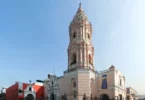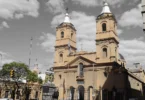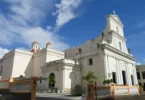Introduction
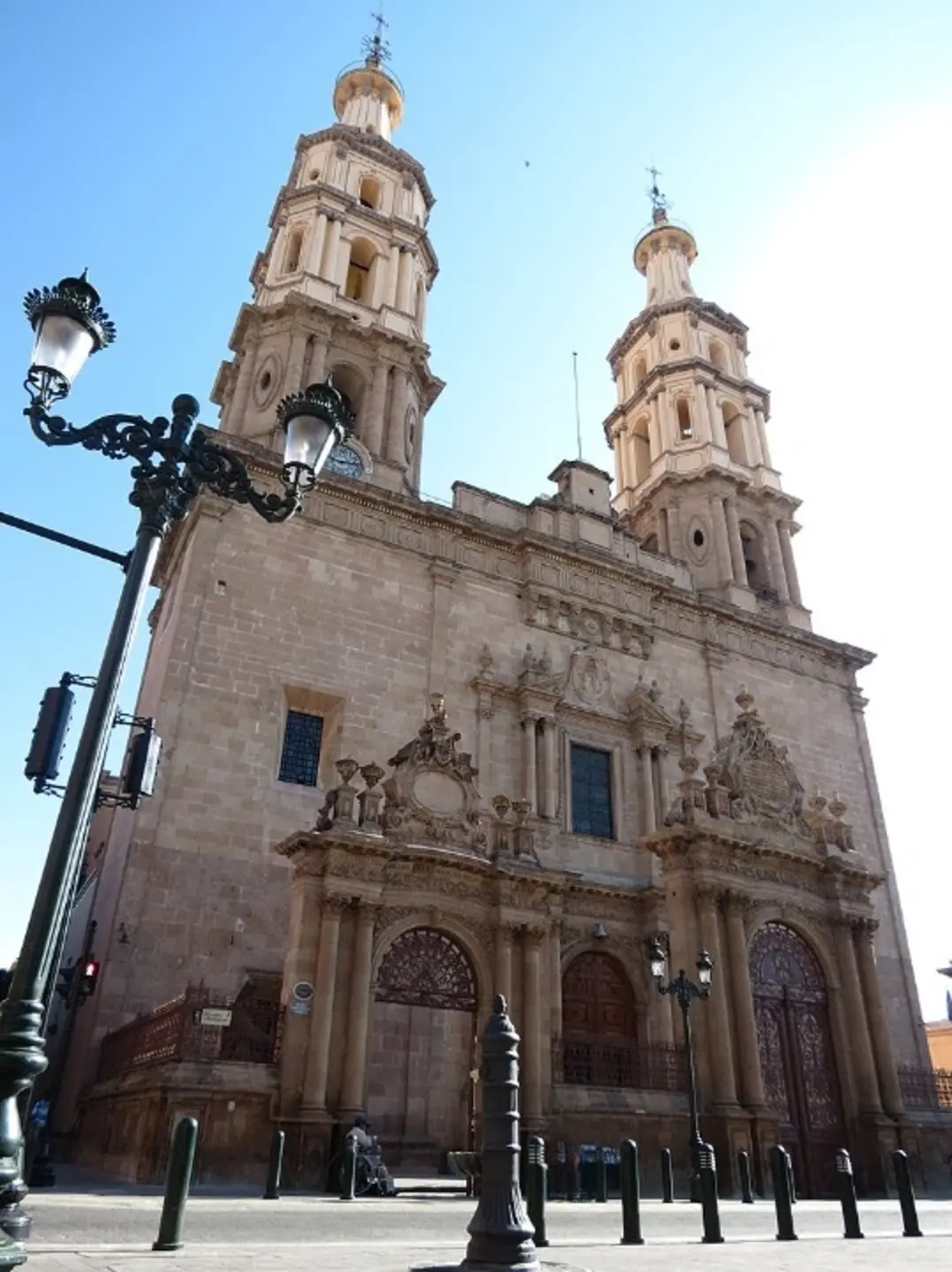
The Cathedral Basilica of Our Lady of the Light, also known simply as León Cathedral, is a beautiful Catholic church situated right in the heart of León’s historic downtown. This cathedral serves as the main church for the Metropolitan Archdiocese of León. Since its consecration in 1866, it has served as the city’s primary spiritual hub for a considerable amount of time. The parish of San Sebastián Mártir, also known as the parish of the Tabernacle, encompasses the cathedral’s location. Interestingly, this parish is the oldest one in León, Guanajuato, adding even more historical significance to the cathedral’s location.
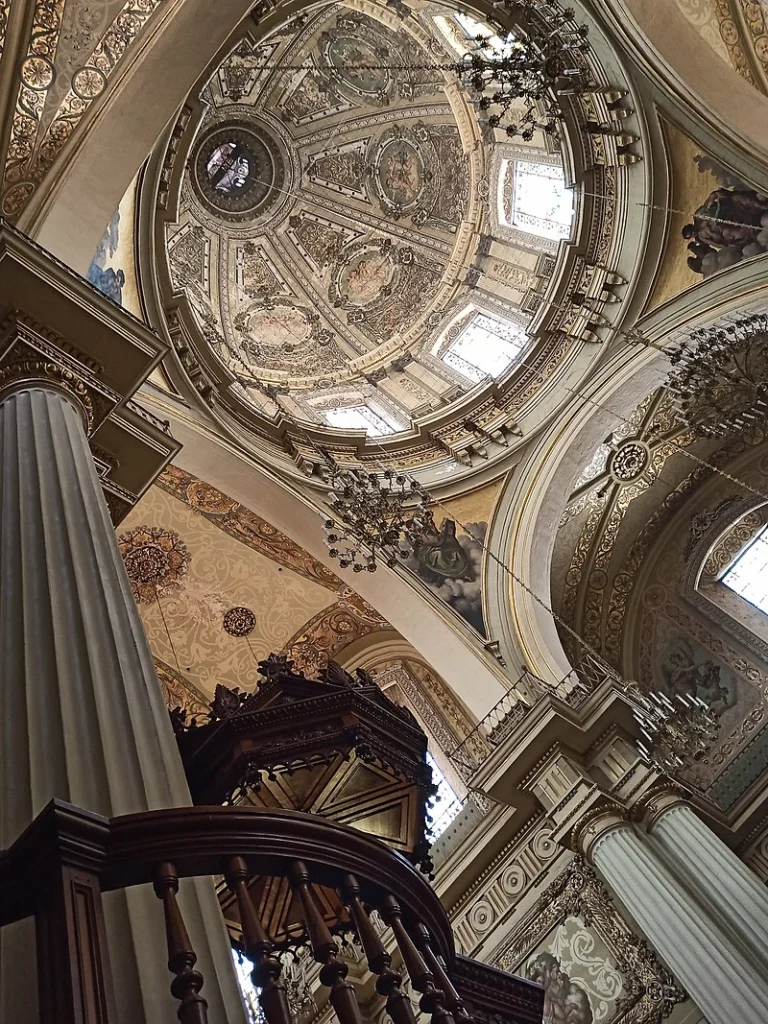
Construction work on the Temple of the New Company, the future site of the Cathedral, began in 1732 upon the return of the Jesuits to the city, having abandoned it a year earlier because their Temple of the Holy School or Old Company was in a state of extreme disrepair. The new temple was to be dedicated to the Most Holy Mother of Light, but with the expulsion of the Jesuits in 1767, work was halted, leaving the walls built just 8 meters above the foundations, as well as the western façade. The building remained in this state until the 1830s, when the Obregón family resumed construction with the support of José Ignacio Aguado . In 1842, several members of the city council requested the residents’ cooperation to continue the work. Some repairs were made in 1855. The Diocese of León was founded on February 21, 1864; immediately after its new bishop José María de Jesús Diez de Sollano took office , the completion of this temple was ordered, which was popularly known as Compañía Nueva and which was established as a cathedral. By then the vaults were finished (1833-1837), the first body of the eastern tower was re-founded (1864), the largest bell with a weight of 4.5 tons was cast in the months of December 1865 and January 1866. The main dome has a height of 42 m, designed by Manuel Gómez Ibarra, amalgamating styles but with many neoclassical features; it was executed by Herculano Ramírez and was completed in August 1865. It was consecrated on March 17, 1866, still unfinished. It was renovated between 1885 and 1889 by Luis Long, and later in 1902 by Ernesto Brunel for the coronation of the Virgin. On August 5, 1920, it was granted the status of a basilica.
Architecture of Cathedral Basilica of Our Lady of the Light, León, Mexico
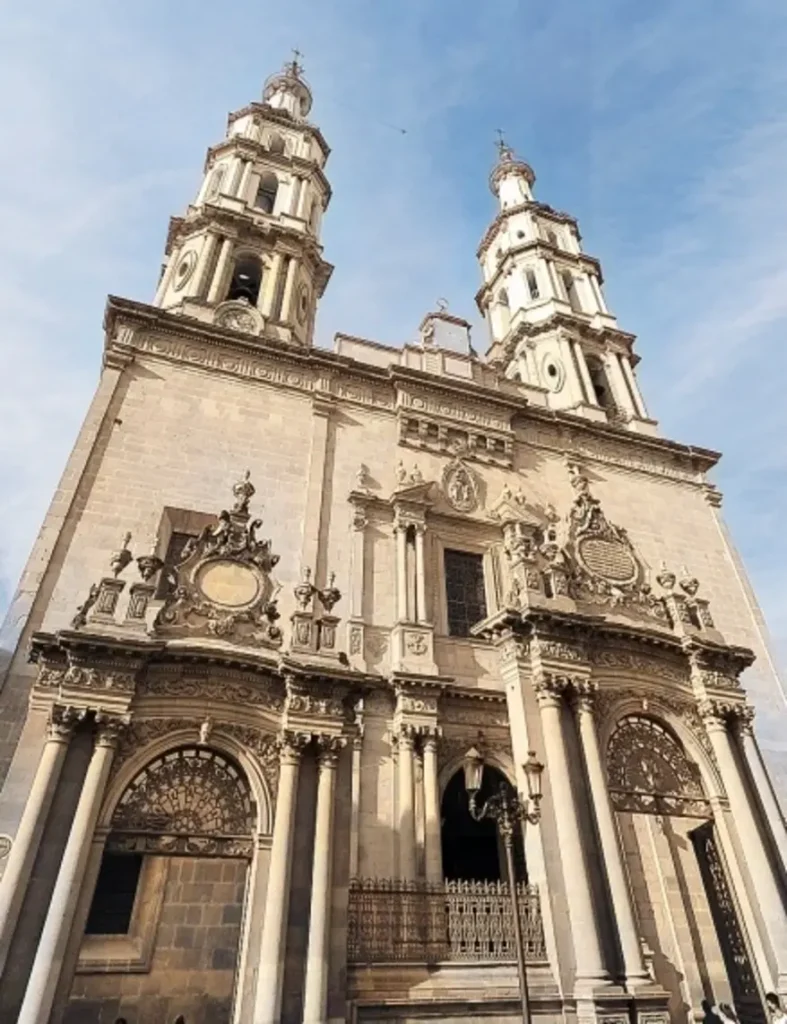
Architectural style: Neoclassical architecture
The facade
The façade is entirely covered in quarry stone, and the pilasters and cornices have elegant moldings and simple fretwork. It has two levels: the first has two pairs of Corinthian columns supporting a frieze framing the semicircular entrance arch. The second level also features two Corinthian columns framing the choir window. The columns of the second level support a pediment interrupted in the center by a medallion with a relief of two angels holding the monogram of the Virgin. Due to its location, the cathedral has a small atrium surrounded by a low quarry wall supported by iron railings. The three entrances are surrounded by impressive quarry porticoes and artistic iron gates with openwork and reliefs. A small base supports a statue of John Paul II on its left side. It has two three-section towers of identical construction. On January 19, 1876, the eastern tower and its twin were completed. They stand 70 m high.

The interior
The church has a Latin cross layout, with a single nave measuring 72 m long by 13 m wide, and a transept with two altars at each end, dedicated to the Immaculate Conception and the Virgin of Guadalupe. Within the nave, there are six additional altars, three on each side. The interior is neoclassical, as are the stained-glass windows made in Munich, Germany. The main marble altar with monolithic columns houses the image of the Virgin. It started out without an apse and with a high wooden altar. In 1889, the original high altar was taken down and a new one made of quarry designed by Luis Long was installed in its place. This in turn was replaced by the current one in 1902, made of Italian Carrara marble, Tennessee granite, and gilt bronze. Ernesto Brunel designed it, expanding the presbytery arch, adding the apse, and a new dome. Most of the building is decorated in the neoclassical style.
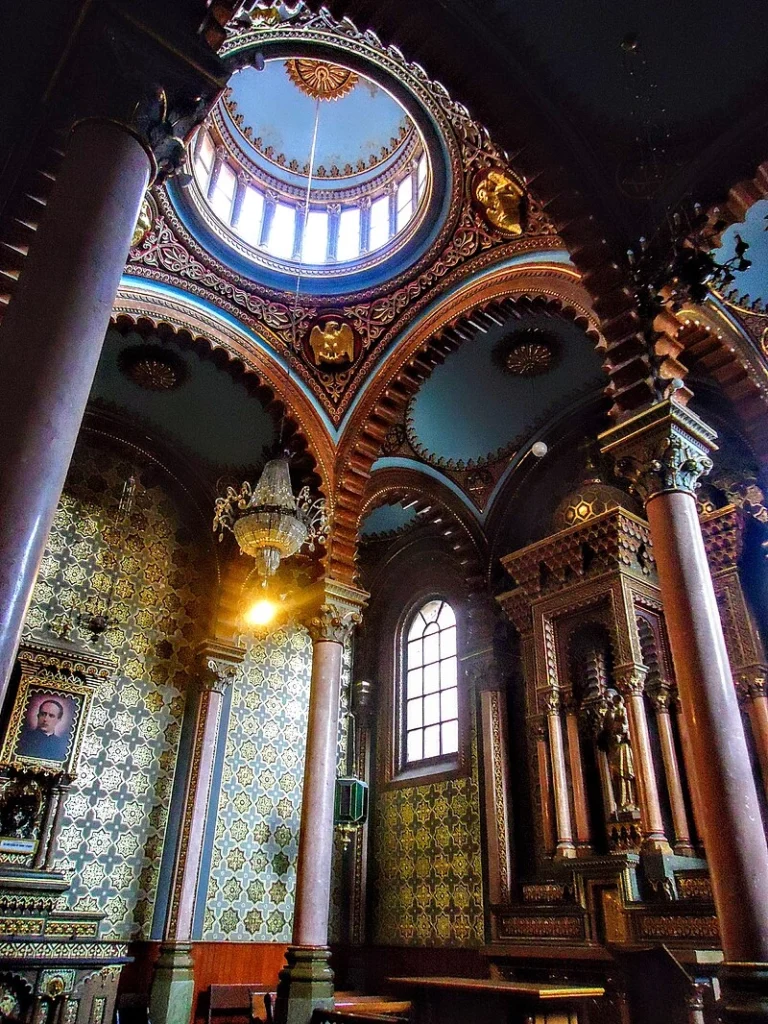
The chapels
Chapel of the Virgin of Loreto
On July 18, 1876, the keystone of an arch on one side of the north door came loose, which was the reason for the complex to grow because Bishop Diez de Sollano, when imploring divine intervention, promised the construction of a chapel that was located on the west side, he kept his promise by erecting the current chapel of the Virgin of Loreto, made as a replica of the Holy House of Loreto in Italy, the complex was completed in June 1877, but had to be rebuilt about 30 years later, during the administration of Bishop Leopoldo Ruiz y Flores, who blessed it on May 8, 1909, when he was already Archbishop of Linares.
Chapel of Ecce Homo
It was completed in 1884 and houses an image by the artist Felipe Ruiz, commissioned by Francisco Sotomayor.
Chapel of St. Joseph
It was commissioned by Bishop Barón y Morales to Luis Long . It is located to the east of the cathedral on land that used to belong to the atrium. The construction of this Neo-Mudejar chapel, decorated with splendor and luxurious detail, was directed and executed with true care. It was executed with stone, wood, and stucco. The chapel was blessed on December 19, 1893, the date on which it was inaugurated. The remains of Bishop Barón y Morales rest there.
Chapel of the Virgin of Solitude
At the same time as the Chapel of San José was being built, another chapel was being built on the west side, dedicated to the Sacred Heart of Jesus, funded by Bishop Barón y Morales. However, a few years later, the image of the Sacred Heart was moved to a side altar, and the place of honor in this chapel was taken by an image of the Virgin of Solitude by Perrusquia.
Chapel of Christ the King
The sculpture of Christ the King, a true religious symbol for Catholics, is inspired by the White Christ currently housed in León Cathedral and considered one of the most valuable artistic sculptures. In León, the White Christ Chapel was begun in 1937, 10 years after the first monument was dynamited, amidst the religious persecution of then-President Plutarco Elías Calles. The chapel was the initiative of Bishop Emeterio Valverde y Téllez, erected in late 1937, and blessed on January 11, 1938, to replace the monument that was to be built on El Cubilete Hill in 1923.

Bell tower
The bell tower occupies the first floor of both towers and has two bells, two small bells, two larger bells, and one small golden bell. The smaller of the two larger bells is used to call to mass and can be heard over a kilometer and a half away. In the north tower is the clock’s carillon, built in France and arranged by the architect and watchmaker Luis Long. It has four semispherical bells, three of which ring every quarter of an hour and the largest every hour. It was installed and began operating in May 1885. In the same north tower, there is a rattle approximately 1.60 m in diameter that is rung only on Holy Thursday and Good Friday.
North Tower
The north tower houses the clock, the carillon, the giant “San José” bell, a small golden bell, and the wooden rattle.
South Tower
In the south tower, there are three bells and two bells. Two of the three are medium-sized, while the other is “La Madre Santísima de la Luz,” which is normally used to call to mass and is large. Both bells are large. One of the two bells, ” Nepomuceno ,” is the largest bell in the Americas, measuring over 2.5 meters in height.
The image of the Holy Mother of Light
For the devotion to the Most Holy Mother of Light, the first bishop of León, Díez de Sollano, decreed that the image venerated in a painting that presided over the main altar of the Temple of the Holy School and that had arrived in León on July 2, 1732, be recognized as the Patron Saint of the Diocese. The painting was moved to the provisional cathedral, the parish of El Sagrario, and once the definitive cathedral was completed, it was placed in the central position of the Altar, all with the due celebrations and honors. It held a special place in the local religion from that point on. This picture, which came to León from Palermo, Italy, as a gift from the Jesuit Juan Antonio Genovessi, is said to have had a miraculous beginning and a fateful choice.
Benedict XVI’s visit to the Leonese Cathedral
On Sunday, March 25, 2012, then-Pope Benedict XVI celebrated Vespers with the bishops of Mexico and Latin America inside the Cathedral Basilica of Our Lady of Light.
Feast Day
Feast Day : 04 June
The Cathedral of León, Guanajuato, dedicated to Our Lady of the Light, celebrates its feast day on the Wednesday before Pentecost each year. This tradition honors the Virgin Mary under the title Nuestra Señora de la Luz, who is the city’s patroness. In 2025, the feast falls on June 4. The celebration typically includes special masses, processions, and devotional activities at the cathedral located in León’s historic center.
Church Mass Timing
Monday to Sunday : Yet to Update
Church Opening Time:
Monday to Sunday : Open 24 hours
Contact Info
Address : Cathedral Basilica of Our Lady of the Light
Álvaro Obregón 112, Centro, 37000 León de los Aldama, Gto., Mexico
Phone : +52 477 716 1038
Accommodations
Connectivities
Airway
Cathedral Basilica of Our Lady of the Light, León, Mexico, to Guanajuato International Airport, distance between 30 min (28.2 km) via Blvd. Adolfo López Mateos and México 45.
Railway
Cathedral Basilica of Our Lady of the Light, León, Mexico, Leon Hacendado train staition, distance between 10 min (3.9 km) via Blvrd Venustiano Carranza.



